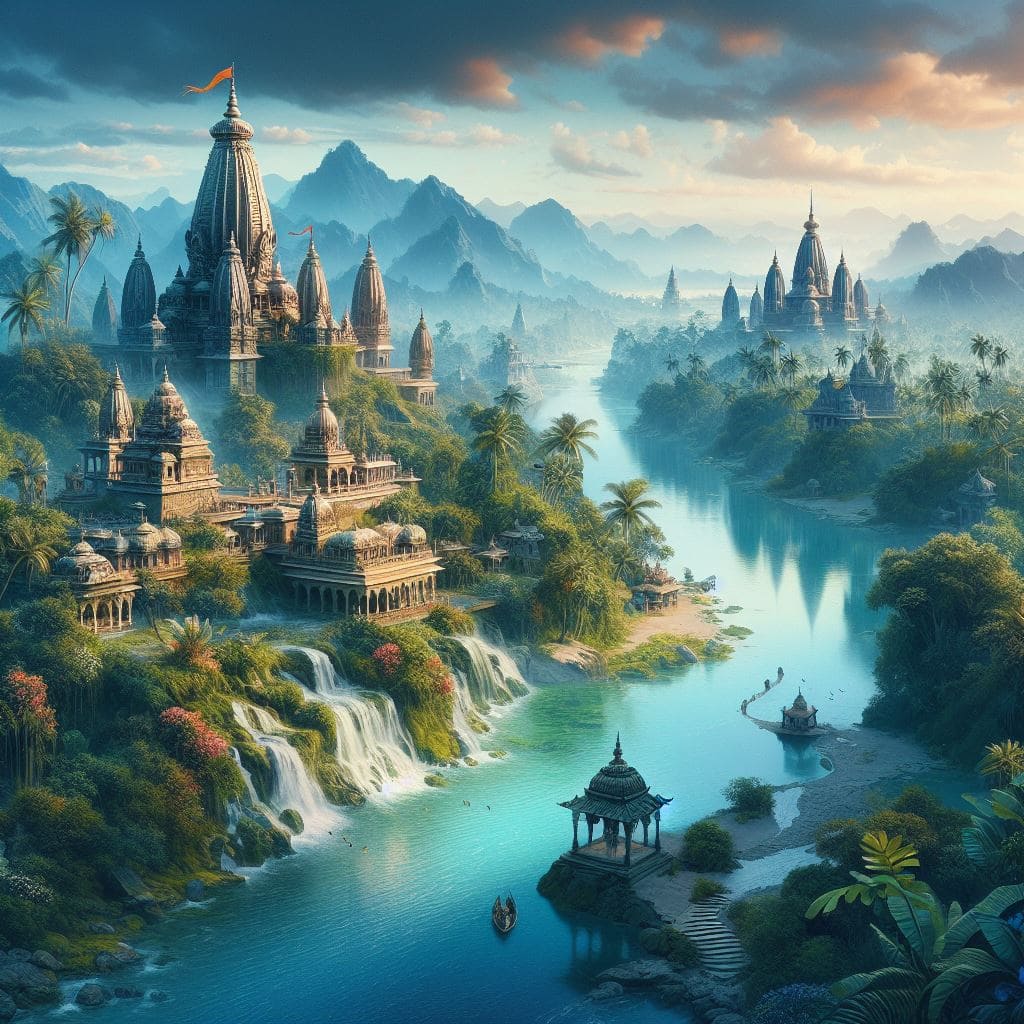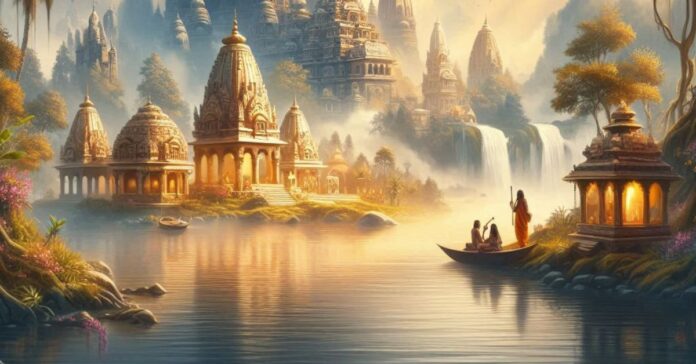
Imagine a world where stories are more than just tales; they are the lifeblood of a civilization, the pulse of a vibrant and ancient culture. Welcome to the world of the Puranas, the timeless narratives that form the cornerstone of Hindu dharma and culture. These ancient texts, composed over millennia, are not just relics of the past but living documents that continue to inspire, educate, and guide millions. They weave together cosmology, mythology, genealogy, folklore, and spiritual teachings into an intricate tapestry that defines the essence of Hindu life and thought.
The Origin and Structure of the Puranas
The Puranas, derived from the Sanskrit word “Purana” meaning “ancient” or “old,” are a collection of texts that date back to at least the first millennium BCE, with some scholars suggesting that their oral traditions may be even older. These texts are traditionally classified into eighteen Mahapuranas (great Puranas) and numerous Upapuranas (minor Puranas). Each text is a rich mosaic of stories, hymns, and dialogues, often presented in a conversational format where sages, gods, and devotees engage in profound discussions.
The Eighteen Mahapuranas
The eighteen Mahapuranas are considered the most significant among these texts. Each one is unique, focusing on different aspects of the cosmos, divine beings, and philosophical concepts. Here is a glimpse into these fascinating works:
- Brahma Purana: Emphasizes the creation of the universe and the genealogy of gods, sages, and kings.
- Padma Purana: Named after the lotus (Padma), it narrates the creation of the world, the deeds of Vishnu, and stories of other deities.
- Vishnu Purana: Highlights the avatars (incarnations) of Vishnu and the cosmic cycles of creation and destruction.
- Shiva Purana: Dedicated to Shiva, it recounts his deeds, myths, and rituals.
- Bhagavata Purana: Celebrated for its poetic and devotional narratives, particularly the life of Krishna.
- Narada Purana: Focuses on religious duties, rites, and various legends.
- Markandeya Purana: Contains the Devi Mahatmya, glorifying the goddess Durga.
- Agni Purana: Named after the fire god Agni, it covers a wide range of topics, from cosmology to medicine.
- Bhavishya Purana: Known for its prophecies about the future (Bhavishya).
- Brahmavaivarta Purana: Emphasizes the creation and the divine play of Krishna.
- Linga Purana: Centers on the worship of Shiva’s symbolic representation, the Linga.
- Varaha Purana: Named after Vishnu’s boar avatar, Varaha.
- Skanda Purana: Dedicated to Kartikeya (Skanda), the god of war.
- Vamana Purana: Details the Vamana avatar of Vishnu and the creation myths.
- Kurma Purana: Named after the turtle avatar of Vishnu, Kurma.
- Matsya Purana: Focuses on Vishnu’s fish avatar, Matsya.
- Garuda Purana: Named after Vishnu’s mount, Garuda, and discusses life after death.
- Brahmanda Purana: Explores the creation of the cosmos and the genealogy of gods and sages.
The Upapuranas
The Upapuranas, though less renowned, are equally valuable, offering additional narratives and teachings. These texts complement the Mahapuranas and provide further insights into Hindu dharma and culture. Some well-known Upapuranas include the Sanatkumara Purana, the Narasimha Purana, and the Parashara Purana.
Themes and Content of the Puranas
The Puranas are encyclopedic in nature, covering a broad spectrum of themes. Their rich narratives delve into cosmology, mythology, genealogy, religious rites, and philosophical teachings, making them a treasure trove of ancient wisdom.
Cosmology and Creation Myths
The Puranas offer detailed accounts of the universe’s creation, preservation, and eventual destruction. These cosmological narratives often feature the Hindu trinity: Brahma (the creator), Vishnu (the preserver), and Shiva (the destroyer). For instance, the Vishnu Purana describes the creation of the universe from the primordial waters, with Vishnu resting on the cosmic serpent Ananta, and Brahma emerging from a lotus growing from Vishnu’s navel. This vivid imagery not only captures the imagination but also conveys profound philosophical truths about the cyclical nature of existence.
Mythology and Legends
Rich in mythology, the Puranas recount the exploits of gods, goddesses, heroes, and demons. These stories serve as moral and spiritual allegories. The Bhagavata Purana, for example, is renowned for its detailed narration of Krishna’s life, from his mischievous childhood exploits in Vrindavan to his role as a charioteer and divine guide in the Mahabharata war. These tales are not just entertaining but also imbued with deep ethical and spiritual lessons.
Genealogy and Dynastic Histories
Many Puranas contain extensive genealogies of gods, sages, and royal dynasties, tracing their origins and relationships. These genealogical accounts establish a sense of continuity and legitimacy, connecting historical figures with mythological ancestors. The Vishnu Purana, for instance, traces the genealogies of the Solar and Lunar dynasties, linking historical kings with divine progenitors.
Religious Rites and Practices
The Puranas provide detailed guidelines for various religious rites, rituals, and festivals. They describe the procedures for conducting pujas (worship), yajnas (sacrificial rituals), and other ceremonies. The Agni Purana, for instance, is a comprehensive manual on rituals, covering everything from temple construction to the consecration of images. These detailed instructions ensure that religious practices are performed correctly, preserving the sanctity and efficacy of the rituals.
Moral and Philosophical Teachings
Embedded within the stories and legends of the Puranas are profound moral and philosophical teachings. They address fundamental questions about life, death, karma (action), dharma (duty), and moksha (liberation). The Markandeya Purana, for example, includes the Devi Mahatmya, which extols the virtues of the goddess Durga and underscores the triumph of good over evil. Through these narratives, the Puranas impart timeless wisdom, guiding individuals on their spiritual journey.
The Role and Significance of the Puranas in Hindu Dharma and Culture
The Puranas are not just texts but living traditions that continue to shape and enrich Hindu dharma and culture. They serve multiple roles in society, preserving oral traditions, popularizing Vedic teachings, promoting bhakti (devotion), inspiring art and literature, and providing social and ethical guidance.
Preservation of Oral Traditions
One of the primary roles of the Puranas has been the preservation of oral traditions. For centuries, these texts were transmitted orally, ensuring that the wisdom and knowledge of the Vedic age were not lost. The narrative format, with its engaging stories and dialogues, made it easier for these traditions to be memorized and passed down through generations. This oral tradition has kept the Puranas alive and relevant, adapting to changing times while preserving their core teachings.
Popularization of Vedic Teachings
The Puranas played a crucial role in popularizing the teachings of the Vedas. While the Vedas are considered the ultimate source of spiritual knowledge, they are often abstract and difficult to understand. The Puranas, with their stories and parables, made Vedic knowledge accessible to the common people. By weaving complex philosophical concepts into simple narratives, the Puranas ensured that Vedic wisdom could be understood and appreciated by all, transcending social and educational barriers.
Promotion of Bhakti (Devotion)
The Puranas are instrumental in the development and promotion of the bhakti movement, which emphasizes personal devotion to a deity as the path to salvation. Texts like the Bhagavata Purana, with its focus on the worship of Krishna, have been pivotal in fostering devotional practices. The stories of Krishna’s divine play (lila), his interactions with his devotees, and his miracles inspire deep devotion and love for God. This emphasis on bhakti has made the Puranas accessible and appealing to people from all walks of life, fostering a personal and emotional connection with the divine.
Cultural and Artistic Inspiration
The Puranas have been a rich source of inspiration for Indian art, literature, music, and dance. The themes and characters from the Puranas are depicted in various art forms, from temple sculptures and paintings to classical dance and drama. The stories of Rama and Krishna, in particular, have inspired countless works of art and literature, enriching India’s cultural heritage. This artistic expression ensures that the Puranic stories remain alive and vibrant, continually reinvented and reinterpreted by each generation.
Social and Ethical Guidance
In addition to their religious and spiritual teachings, the Puranas offer guidance on social and ethical matters. They address issues such as governance, justice, and social responsibilities, providing a moral framework for individuals and society. The narratives often highlight the consequences of righteous and unrighteous actions, reinforcing the importance of dharma. This ethical guidance helps to shape the moral values and social norms of Hindu society, promoting harmony and justice.
Prominent Puranic Stories and Their Significance
The Puranas are replete with stories that have captivated the imagination of Hindus for centuries. These narratives are not only entertaining but also carry deep symbolic and philosophical meanings.
The Churning of the Ocean (Samudra Manthan)
One of the most famous stories in the Puranas is the churning of the ocean, or Samudra Manthan, found in the Bhagavata Purana, Vishnu Purana, and several other texts. This story describes how the gods (devas) and demons (asuras) collaborated to churn the ocean of milk to obtain the nectar of immortality (amrita). Using Mount Mandara as the churning rod and the serpent Vasuki as the rope, they churned the ocean with Vishnu’s help, who took the form of a tortoise (Kurma) to support the mountain.
This story symbolizes the eternal struggle between good and evil and the efforts required to attain spiritual enlightenment. The various objects and beings that emerged during the churning, including the deadly poison (halahala) and the divine nectar, represent the challenges and rewards on the spiritual path. The poison, which Shiva consumed to save the world, symbolizes the selfless sacrifice and the need to overcome negative influences. The nectar represents the ultimate goal of spiritual pursuits—immortality and union with the divine.
The Descent of the Ganga (Ganga Avatarana)
The story of the descent of the Ganga is another popular Puranic tale, recounted in the Vishnu Purana, the Ramayana, and the Mahabharata. It narrates how King Bhagiratha performed severe penances to bring the river Ganga down from the heavens to purify the ashes of his ancestors. Lord Shiva agreed to receive the mighty river on his head to prevent its force from destroying the earth, and then gently released it to flow on the earth.
This story underscores the themes of devotion, perseverance, and divine grace. Ganga’s descent is celebrated as a symbol of purification and spiritual renewal, and the river Ganga remains one of the most sacred rivers in Hinduism. The narrative highlights the importance of sincere effort and divine intervention in achieving one’s goals, reflecting the interdependence of human endeavor and divine grace.
The Birth of Kartikeya
The story of the birth of Kartikeya, the god of war, is found in the Skanda Purana, Shiva Purana, and other texts. Kartikeya, also known as Skanda or Murugan, was born to Shiva and Parvati to defeat the demon Tarakasura. His birth and subsequent victory over the demon are celebrated with great fervor, particularly in South India.
This story highlights the themes of divine intervention and the victory of good over evil. Kartikeya’s youthful energy and martial prowess make him a beloved deity, especially among the youth. His story inspires courage, determination, and the importance of standing up against injustice.
The Life of Krishna
The Bhagavata Purana provides a detailed account of the life and exploits of Krishna, one of the most revered deities in Hinduism. From his miraculous birth and childhood pranks in Vrindavan to his role as a charioteer and advisor in the Mahabharata war, Krishna’s life is depicted in vivid detail. The stories of his divine love with Radha and his interactions with the gopis (milkmaids) are particularly cherished.
Krishna’s life embodies the principles of dharma, devotion, and divine love. His teachings in the Bhagavad Gita, delivered on the battlefield of Kurukshetra, are a philosophical cornerstone of Hinduism, addressing the nature of duty, righteousness, and the self. Krishna’s playful and compassionate nature, coupled with his profound wisdom, makes him a multifaceted and deeply relatable deity.
The Glory of Devi
The Markandeya Purana contains the Devi Mahatmya, a powerful narrative celebrating the goddess Durga’s triumph over the buffalo demon Mahishasura. This text extols the glory of the divine feminine and her role as the protector and sustainer of the universe.
The Devi Mahatmya emphasizes the power and compassion of the goddess and underscores the importance of divine grace in overcoming obstacles and evil. The text is central to the worship of the goddess during the festival of Navaratri, a major Hindu celebration. The story highlights the strength and resilience of the divine feminine, inspiring reverence and respect for women and the feminine principle in the universe.
The Puranas in Modern Context
Despite their ancient origins, the Puranas continue to be relevant in contemporary times. They offer timeless wisdom and insights that resonate with modern spiritual seekers and practitioners.
Spiritual and Religious Practices
The Puranas remain a vital part of Hindu religious life. They are recited and studied during festivals, religious ceremonies, and daily worship. The stories and teachings of the Puranas inspire devotion, provide moral guidance, and offer solace and hope. They are a source of spiritual nourishment, helping individuals connect with their inner selves and the divine.
Cultural Preservation
In a rapidly changing world, the Puranas help preserve India’s rich cultural and religious heritage. They serve as a link to the past, connecting modern Hindus with their ancestral traditions and values. By engaging with the Puranic narratives, individuals and communities can maintain a sense of continuity and identity. The Puranas are a living testament to the enduring power of storytelling in preserving cultural memory and heritage.
Ethical and Moral Guidance
The moral and ethical teachings embedded in the Puranas continue to be relevant. They address universal themes such as justice, righteousness, compassion, and the consequences of one’s actions. In an age where ethical dilemmas are increasingly complex, the Puranas offer a timeless moral compass. They provide practical wisdom and guidance for leading a righteous and fulfilling life.
Inspiration for Art and Literature
The Puranas continue to inspire contemporary art, literature, and popular culture. From classical dance performances and theatrical adaptations to modern films and novels, the themes and characters of the Puranas find new expressions in various creative forms. This ongoing engagement ensures that the stories and values of the Puranas remain alive and vibrant. They are a source of endless inspiration, fueling creativity and artistic expression.
Interfaith Dialogue and Understanding
In an increasingly interconnected world, the Puranas offer valuable insights for interfaith dialogue and understanding. By exploring the rich narratives and teachings of the Puranas, individuals from different religious and cultural backgrounds can find common ground and appreciate the universal themes of spirituality and ethics. The Puranas promote a message of unity and harmony, encouraging mutual respect and understanding.
Conclusion
The Puranas are more than just ancient texts; they are the heartbeat of Hindu dharma and culture. Their narratives, teachings, and wisdom offer timeless insights into the nature of the universe, the divine, and the human condition. By preserving and engaging with the Puranas, we can draw from their profound spiritual heritage and apply their lessons to our contemporary lives.
In a world that often seems fragmented and uncertain, the Puranas remind us of the enduring values of dharma, devotion, and the eternal quest for truth. Their stories inspire us to look beyond the mundane, to seek the divine within and around us, and to live our lives with purpose and compassion. As we delve into the Puranas, we embark on a journey of discovery, connecting with the ancient wisdom that continues to illuminate our path.
So, the next time you encounter a story from the Puranas, remember that you are not just reading a tale but stepping into a world of timeless wisdom, vibrant culture, and profound spirituality. Embrace the journey and let the Puranas guide you towards a deeper understanding of yourself and the universe.








